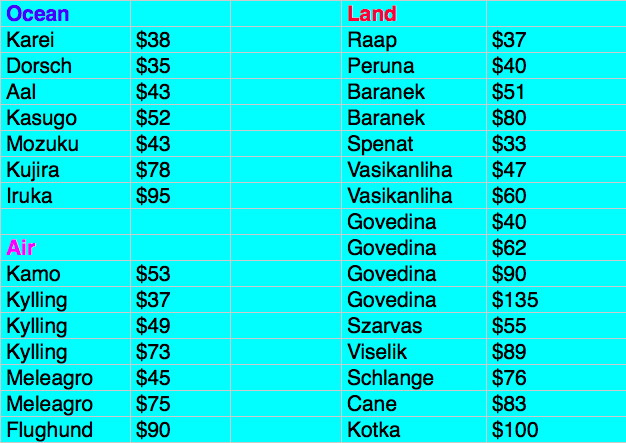Sharpen your poison pens, sommeliers, because you’re going to hate this column.
When I’m dining in one of the trendy restaurants I love, I often think about how impenetrable the wine list must look to the uninitiated. But all of us reading this, we know what Quincy and Alicante Bouschet and Auslese mean, so it doesn’t bother us. We might not even remember what it’s like to look at a list and be utterly bewildered.
I created this menu to bring that experience home.
So, are you ready to order?
This is EXACTLY like a wine list. It gives the name of the product, in the language of the country that produced it. It gives a price. Some are more expensive than others; we don’t know why.
So, are you ready to order?
Not just for enthusiasts
One of my longtime rants about wine lists is that they look like this: a bunch of mysterious words that only make sense if you know the language. People used to say wine is the only beverage you need a special tool to open. Fortunately we now have screwcaps, but it’s still the only beverage you need special knowledge to order.
And as the wine world has expanded this has gotten worse.
Don’t misunderstand me: I’m not pining for the old days when our only choices were Cabernet and Chardonnay and maybe a little Pinot Noir. I’m the guy who orders the Croatian Teran because I like that iron-rich flavor, or the intentionally oxidized Alvarinho.
I also know I’m among the scant 12% of American consumers who are “enthusiasts,” according to Constellation Brands’ 2008 “Project Genome” study. I’ll bet that even among that group, I’m in the upper 5% of geekdom. I’m not asking for sommeliers to write wine lists that I like; you’re doing that already. I’m asking you to think about the other 88%.
So, are you ready to order?
Talk to me
Sometimes when I go on this rant, sommeliers say that they want the customers to talk to them. They’re able to answer any questions about the wine. Never mind that it might be their night off, or they might be over at my table comparing notes on our favorite regions in Beaujolais.
But beyond that, when the list reads like the one at the top, where do you start asking questions? What’s the difference between Vasikanliha and Govedina? Is the $90 Govedina really twice as good as the $40 Govedina? What does the $45 Meleagro taste like?
Don’t you have any wines I know, like Jordan or Silver Oak or Cupcake?
So, are you ready to order?
It’s all Japanese to me
When I lived in Tokyo, I learned to read Japanese food menus a little at a time. I learned the characters for raw fish, cooked fish, chicken, pork, beef. Then I learned useful characters for yakitori (grilled chicken) restaurants, like those for heart and liver and gizzard. I could walk into most restaurants in Tokyo with confidence, ignore the few dishes I couldn’t read and order what I wanted.
Then I went to Sapporo with a visiting American friend and walked into a fish restaurant. They have different species of fish there, and a regional dialect. And the restaurant had a stylishly handwritten menu, which made the characters much harder, as I was used to precise computer-printed words.
All of these points are indicators of a good restaurant, including the care put into the menu calligraphy. But I couldn’t read anything except the sake menu, and even on that I could only read the classifications, not the brands. My friend was depending on me to order. I could point at something, but I really had no idea what we would get. I’m an adventurous eater; my friend, not as much. We left and went to a less promising restaurant that had a computer-printed menu.
I’ve never forgotten not only the experience, but the feeling. Flustered. Embarrassed. Helpless. I spoke Japanese well enough at that point to ask about any single item on the menu. But I couldn’t imagine sitting there asking about the entire menu.
Did I mention embarrassed? That menu did more than stymie me; it shamed me.
So, are you ready to order?
Descriptions, please?
 Back to that menu above. All of the foods are edible. Some are quite delicious. But there are a few things on there that you might not want to eat. I, being a culinary adventurer, have already tried all of them, though 3 of them I was served without knowing what they were and would not have eaten had I known.
Back to that menu above. All of the foods are edible. Some are quite delicious. But there are a few things on there that you might not want to eat. I, being a culinary adventurer, have already tried all of them, though 3 of them I was served without knowing what they were and would not have eaten had I known.
And then there’s the cost. The dog stew I wish I hadn’t ordered in the Philippines cost about $4. If I didn’t like it, I could have just left it on the table. I wouldn’t have felt like, “we paid $60 for this so we better finish it no matter what.”
Sommeliers, would it kill you to put a brief description of the wines on your list, where people can read it before you come to the table? We talk all the time on this site about how people should drink real wines with real stories. Would it kill you to include that story: “Old vines, dry farmed by a 4th generation vintner.” Or “Less ripe than most. Good with the roast pork.” Or whatever. It would be useful information to at least 88% of wine drinkers in America.
So, are you ready to order yet? What are you waiting for?

